John Barnwell
-
- The Changing Face of Piracy Maritime Logistics Professional, Q1 2014 #24
Rich Energy Targets helps to keep Piracy in the Public Spotlight
The release of the Captain Phillips movie starring Tom Hanks in October 2013 and the hijacking of two Americans off the coast of Nigeria have brought more public attention to the oldest of all maritime risks: piracy. While piracy has been a concern in the maritime industry for centuries, a new hotspot has emerged off the coast of West Africa in the Gulf of Guinea. Specifically the industry is concerned about attacks occurring in the territorial waters of Benin, Nigeria, Togo and the Ivory Coast. Over the past years, there have been more widespread and violent accidents in this region of the world. In fact, over the summer of 2013, 22 West African states signed a code of conduct regarding piracy prevention and armed robbery against ships. United States Navy ships accompanying the EU Naval Force off Somalia have created an effective ‘international recommended transit corridor.’ Several West African leaders are calling for a similar floating police force in the Gulf of Guinea, one of the most active oil transport and energy hubs in the world today.
At the same time, shipping companies are continuing to report piracy incidents in the Gulf of Aden and the Strait of Malacca in Southeast Asia. Piracy attacks have dropped significantly off the coast of Somalia due to various factors, including active military action, land-based anti-piracy interventions and the increasing use of armed guards on board of ships. However, Allianz Global Corporate & Specialty (AGCS), a leading marine insurer, maintains that this region is still far from safe from pirate attacks. The industry sometimes likens the issue of piracy to a game of ‘whack-a-mole’.
Once one area quiets down a little, there is another hotspot emerging. So overall, it continues to be of great concern to our clients and with that to us.
Changing business models of pirates
Types of piracy in different regions of the world vary. This is important since the management best practices issued by the International Maritime Organization are still focused on the type of piracy that prevailed off the coast of Somalia. Different types of piracy include:- Opportunistic armed robbery occurs when a vessel is approaching or anchored off ports or when ship-to-ship transfers take place (e.g. oil or gas cargo). Usually pirates are after valuables, IT equipment, personal belongings and the cash often kept by the ship’s captain for conducting normal business in foreign countries.
- Cargo theft, mainly fuel oil theft, occurs when vessels are hijacked for several days and oil is transferred to a smaller vessel. This usually involves a criminal element and some maritime insider knowledge.
- Kidnapping is usually associated with the offshore oil industry and the instability of the Niger Delta. Typically, robbery is the main intent.
The main difference between traditional piracy in Somalia and the new wave of piracy emerging in West Africa is that the latter is usually more aggressive and violent and is aimed at obtaining valuables. The pirates often use poles, grapples and ladders and come with two to three skiffs or speedboats.
Piracy frequency numbers
Piracy is a major concern for the marine insurance industry. For instance, the West African territorial waters are excluded from the Hull War trading area and ship owners need to arrange insurance coverage for sailing into such areas in advance. A recent joint study by the International Criminal Police Organization, United Nations office on Drugs and Crime and the World Bank states that from 2005 to 2012, 179 ships were successfully hijacked off the Horn of Africa, primarily off the coast of Somalia. Another study, called ‘Pirate Trails’, using data and evidence from interviews with former pirates, government officials, bankers and others involved in piracy, explores the finances behind piracy and claims that over $339 million in ransom was paid during that period of time.
So what can shipping companies do to prepare for and mitigate the risk of piracy? Tim Donney, Global Head of Marine Risk Consulting at Allianz Global Corporate & Specialty, has some tips for operators shipping in piracy prone waters:- Avoid using very high frequency (VHF) communication, but use secure satellite telephone or email instead
- Vet all communications with external parties and take care when communicating information on cargo onboard to third parties
- Avoid tendering while not immediately conducting cargo operations
- Change routes up occasionally to avoid predictability when a vessel is in the region frequently and following a regular trade route.
- Piracy risk is the greatest at night (the highest risks are between 2200-0300hrs and weekends, Friday to Sunday are the most common days) and increased vigilance is needed. (Operating only in day light hours is not an option for ships.)
- Prior to transiting the Gulf of Aden, alert the Maritime Security Centre for the Horn of Africa (MSCHOA) and advise of your voyage plans. Travel in assigned Transit Groups and utilize the International Recommended Transit Corridor (IRTC), which will allow optimal coordination of naval warships that are operating in the Gulf of Aden.
- Do not refuel in the piracy hotspot areas. For instance, try to refuel in Cape Town in South Africa instead of in the West African region
- Follow the guidelines contained within IMO’s Best Management Practices IV, such as ‘hardening your vessel’ by installing barbed wire to protect the hull and create an effective Citadel aboard ship.
- For vessels transiting West Africa, follow the Guidelines for the Gulf of Guinea, which have been created by Intertanko, BIMCO, NATO and other maritime organizations.
The Use of Armed Guards
The use of armed guard is a legal challenge. In contrast to the international waters off Somalia, coastal states in West Africa do not allow foreign armed guards to enter their territorial waters. Instead, the local navy or army must be used, a process bringing with it lots of uncertainty with respect to naval experience, being able to adapt to critical situations, training and reliability of people sent onboard.
Former US Assistant Secretary of State, Andrew Shapiro stated: “The ultimate security measure a commercial ship can adopt is the use of privately contracted armed security teams. The reason for this is simple: to date, no ship with an armed security team onboard has been successfully pirated.” Yet, there have been instances where fishermen were mistaken for pirates and were inadvertently killed, such as the incident off the coast of India in 2012.
Generally, insurers like Allianz do not endorse or condemn the use of armed guards. If clients choose to use them, then insurers recommend using those that form part of the Security Association for the Maritime Industry (SAMI). This organization certifies maritime security providers worldwide and its members comprise more than 180 security providers, consultants, trainers and maritime security, hardware and technology manufacturers worldwide.
The Root Cause is on Land
Allianz Global Corporate & Specialty has already propagated that more nation building is required in Somalia back in 2011. In Somalia as well as West Africa, the root cause for piracy is the poverty on land and the socio-economic realities of some of the affected countries. One of the driving forces behind piracy in Nigerian waters has been the failure to address the rampant black oil market, making theft a lucrative business. Pirates have become more sophisticated converting fishing trawlers into makeshift oil tankers or bringing some of the captured vessels close enough to the shore in order to siphon the oil into barrels to be sold on the black market. The US obtains 15 percent of its oil supply from this region, so the pirates see ample opportunity for profit here.
Tim Donney stresses: “You have to address the causes and not just the symptoms. And while we are mainly dealing with the transport on water, we need to recognize that the long-term solutions lie on land – whether we are talking about Somalia, West Africa or any other piracy prone area of the world.”
Another contributing factor is the lack of a legal definition of Piracy and lack of legal jurisdiction for prosecution of piracy. The pirate ring leader Muse, who was captured by the US Navy in the Captain Phillips movie, was recently convicted in US federal court for Hijacking, Hostage Taking, & Armed Robbery, but not Piracy. This is because there is no legal definition of Piracy. Also, there is the lack of jurisdiction. Initially, pirates were being tried in Kenya, but the Kenyan government has since taken the position that these are Somali citizens, that attacked ships that are under foreign flags in international waters. So, how does Kenya have any jurisdiction or responsibility to prosecute these pirates? It is reported that over 1,500 pirates have been captured and released by naval ships because of the lack of any legal authority or jurisdiction for their detention or prosecution.
In short, Piracy is a highly complex international problem that continues to exist as long as large income inequalities, poverty and political instability continue to exist. Its face might be changing, but we are still talking about the age-old risk.
(As published in the 1Q 2014 edition of Maritime Professional - www.maritimeprofessional.com)
-
 )
March 2024 - Marine Technology Reporter page: 4
)
March 2024 - Marine Technology Reporter page: 4; Fax: (212) 254-6271 tional in London, perennially one Lof the world’s most important Justin Zuure CEO events serving the global subsea market. John C. O’Malley [email protected] Personally, it was my ? rst return to London for this event since 2018, as the 2020 ‘50th Anniversary’ edition
-
 )
April 2024 - Maritime Reporter and Engineering News page: 28
)
April 2024 - Maritime Reporter and Engineering News page: 28to provide all of the end-to-end logistics the force will require in a future major con? ict. U.S. Navy photo by Mass Communication Specialist 2nd Class John Bellino 28 Maritime Reporter & Engineering News • April 2024 MR #4 (18-33).indd 28 4/5/2024 8:27:05 A
-
 )
April 2024 - Maritime Reporter and Engineering News page: 27
)
April 2024 - Maritime Reporter and Engineering News page: 27Sailors. We have 14 Henry J. Kaiser-class ? eet replen- high-speed craft (HSC) training. So, MyMSC will help track ishment oilers and three of the new John Lewis class of ? eet and manage all of those different things in one place. We’re replenishment oilers, with more on the way. We have 14 Lew- hoping
-
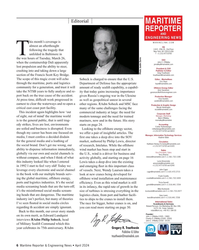 )
April 2024 - Maritime Reporter and Engineering News page: 6
)
April 2024 - Maritime Reporter and Engineering News page: 6St., 2nd Floor following the tragedy that New York, NY 10010 USA T +1.212.477.6700 Tunfolded in Baltimore in the wee hours of Tuesday, March 26, CEO John C. O’Malley when the containership Dali apparently [email protected] lost propulsion and the ability to steer, President & COO Publisher & Editor cra
-
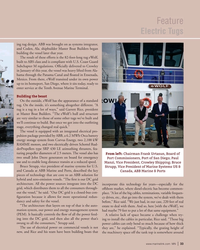 )
April 2024 - Marine News page: 33
)
April 2024 - Marine News page: 33SRP 430 LE azimuthing thrusters, fea- turing propeller diameters of 2.5 meters. The vessel also has From left: Chairman Frank Urtasun, Board of two small John Deere generators on board for emergency Port Commissioners, Port of San Diego; Paul use and to enable long distance transits at a reduced speed. Manzi
-
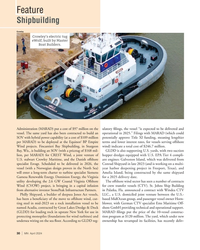 )
April 2024 - Marine News page: 30
)
April 2024 - Marine News page: 30The offshore wind sector has seen a number of contracts Wind (CVOW) project, is bringing in a capital infusion for crew transfer vessels (CTV). St. Johns Ship Building from alternative investor StonePeak Infrastructure Partners. in Palatka, Fla. announced a contract with Windea CTV Philly Shipyard
-
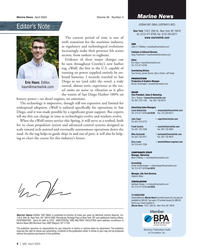 )
April 2024 - Marine News page: 4
)
April 2024 - Marine News page: 4.marinelink.com The current period of time is one of swift transition for the maritime industry, CEO as regulatory and technological evolutions John C. O’Malley • [email protected] increasingly make their presence felt across Publisher & Editorial Director Greg Trauthwein • trauthwein@marinelink
-
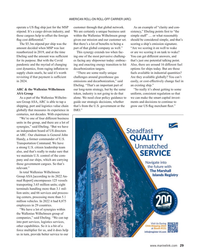 )
February 2024 - Maritime Reporter and Engineering News page: 29
)
February 2024 - Maritime Reporter and Engineering News page: 29units in the group, and there are a lot of synergies,” said Ebeling. “But we have an independent board of US directors at ARC. Our chairman is General John Handy, a former commander of U.S. Transportation Command. We have a strong U.S. citizen leadership team also, and that’s really to make sure that
-
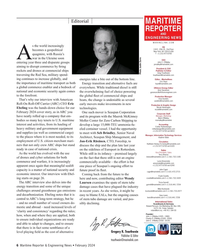 )
February 2024 - Maritime Reporter and Engineering News page: 6
)
February 2024 - Maritime Reporter and Engineering News page: 6HQ 118 E. 25th St., 2nd Floor becomes a geopolitical New York, NY 10010 USA T +1.212.477.6700 quagmire, with Russia’s Awar in the Ukraine soon CEO John C. O’Malley entering year three and disparate groups [email protected] aiming to disrupt commerce by ? ring President & COO Publisher & Editor rocke
-
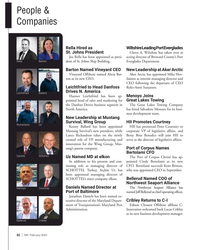 )
February 2024 - Marine News page: 42
)
February 2024 - Marine News page: 42People & Companies Rella Hired as Wiltshire Leading Port Everglades St. Johns President Glenn A. Wiltshire has taken over as Joe Rella has been appointed as presi- acting director of Broward County’s Port Rella Barton dent of St. Johns Ship Building. Everglades Department. Barton Named Vineyard CEO New
-
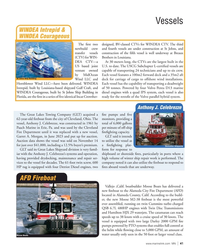 )
February 2024 - Marine News page: 41
)
February 2024 - Marine News page: 41& WINDEA Courageous The ? rst two designed, BV-classed CTVs for WINDEA CTV. The third newbuild crew and fourth vessels are under construction at St Johns, and transfer vessels construction of the ? fth vessel is well underway at Breaux (CTV) for WIN- Brothers in Louisiana. DEA CTV—a At 30 meters long
-
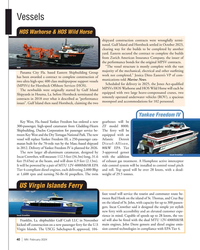 )
February 2024 - Marine News page: 40
)
February 2024 - Marine News page: 40Islands Ferry foot vessel will service the tourist and commuter route be- tween Red Hook on the island of St. Thomas, and Cruz Bay on the island of St. John, with capacity for up to 300 passen- gers. Incat Crowther said it designed the simple yet stylish new ferry with accessibility and an elevated customer
-
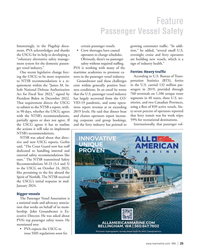 )
February 2024 - Marine News page: 25
)
February 2024 - Marine News page: 25mid- January 2024. Bigger vessels The Passenger Vessel Association is a national trade and advocacy associa- tion that works on behalf of its mem- bership. John Groundwater is Ex- ecutive Director. He was asked about PVA’s top passenger safety issues. He mentioned two: • PVA expects the USCG to issue SMS
-
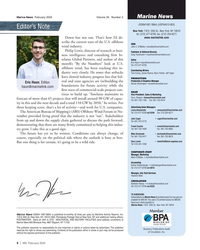 )
February 2024 - Marine News page: 4
)
February 2024 - Marine News page: 4477-6700; fax: (212) 254-6271 www.marinelink.com Down but not out. That’s how I’d de- scribe the current state of the U.S. offshore CEO wind industry. John C. O’Malley • [email protected] Philip Lewis, director of research at busi- Publisher & Editorial Director Greg Trauthwein • trauthwein@marinelink
-
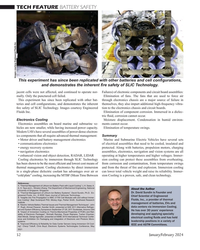 )
January 2024 - Marine Technology Reporter page: 52
)
January 2024 - Marine Technology Reporter page: 52Smith, Southwest Research Institute management of batteries, EVs and 4. “Electric Vehicle Battery Thermal Issues and Thermal Management Techniques”, John data centers via Immersion Cooling. P. Rugh, Ahmad Pesaran, Kandler Smith; presented at SAE 2011 Alternative Refriger- ant and System Ef? ciency
-
 )
January 2024 - Marine Technology Reporter page: 4
)
January 2024 - Marine Technology Reporter page: 4(though not for attribution or reporting) Justin Zuure on the path, direction and importance of the CEO subsea vehicle market. Sitting at that table John C. O’Malley [email protected] that night were several U.S. Navy Admirals as well as the CEOs from about a dozen autonomous underwater vehicle
-
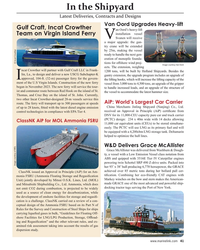 )
January 2024 - Maritime Reporter and Engineering News page: 41
)
January 2024 - Maritime Reporter and Engineering News page: 41ist and commuter route between Red Hook on the island of St. the vessel to accommodate the latest hammer size. Thomas, and Cruz Bay on the island of St. John. Currently, two other Incat Crowther-designed 28-m vessels service this AiP: World’s Largest Car Carrier route. The ferry will transport up to 300
-
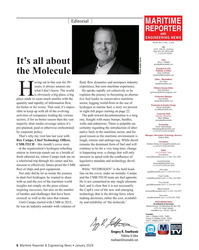 )
January 2024 - Maritime Reporter and Engineering News page: 6
)
January 2024 - Maritime Reporter and Engineering News page: 6Editorial MARITIME REPORTER AND ENGINEERING NEWS M A R I N E L I N K . C O M HQ 118 E. 25th St., 2nd Floor New York, NY 10010 USA T +1.212.477.6700 CEO John C. O’Malley It’s all about [email protected] President & COO Publisher & Editor Greg Trauthwein the Molecule Photo Justin Zurre trauthwein@marinelink
-
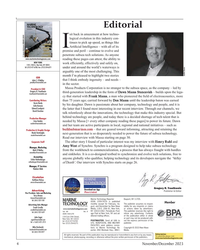 )
November 2023 - Marine Technology Reporter page: 4
)
November 2023 - Marine Technology Reporter page: 4is arguably one of the most challenging. This Justin Zuure month I’m pleased to highlight two stories CEO that I think embody ingenuity – and needs – John C. O’Malley [email protected] in the sector. Massa Products Corporation is no stranger to the subsea space, as the company – led by President
-
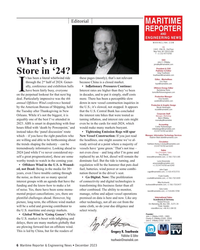 )
December 2023 - Maritime Reporter and Engineering News page: 6
)
December 2023 - Maritime Reporter and Engineering News page: 6Editorial MARITIME REPORTER AND ENGINEERING NEWS M A R I N E L I N K . C O M HQ 118 E. 25th St., 2nd Floor New York, NY 10010 USA T +1 212 477 6700 CEO John C. O’Malley What’s in [email protected] President & COO Publisher & Editor Greg Trauthwein Store in ‘24? [email protected] t has been
-
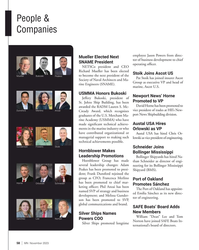 )
November 2023 - Marine News page: 58
)
November 2023 - Marine News page: 58VP and head of rine Engineers (SNAME). marine, Ascot U.S. USMMA Honors Bukoski Newport News’ Horne Jeffery Bukoski, president of Promoted to VP St. Johns Ship Building, has been David Horne has been promoted to awarded the RADM Lauren S. Mc- Merlino Dunsford Anzai Cready Award, which recognizes
-
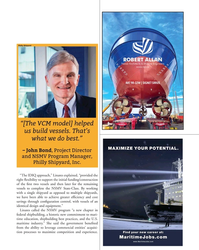 )
November 2023 - Marine News page: 41
)
November 2023 - Marine News page: 41Philly Shipyard “[The VCM model] helped us build vessels. That’s what we do best.” – John Bond, Project Director and NSMV Program Manager, Philly Shipyard, Inc. “The IDIQ approach,” Linares explained, “provided the right ? exibility to support the initial funding/construction of the ? rst two
-
 )
November 2023 - Marine News page: 39
)
November 2023 - Marine News page: 39up to ? ve NSMVs. Keel laying for the Empire State was in May 2021. Ben Christian is TOTE Services’ VP for Business Devel- opment and New Construction. John Bond is Project Di- rector and NSMV Program Manager for Philly Shipyard, Inc. The two were asked for their insights and advisories about the VCM process
-
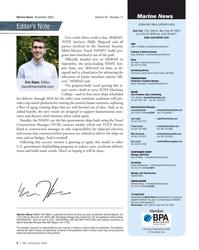 )
November 2023 - Marine News page: 4
)
November 2023 - Marine News page: 4254-6271 www.marinelink.com Give credit where credit is due. MARAD, TOTE Services, Philly Shipyard and all CEO parties involved in the National Security John C. O’Malley • [email protected] Multi-Mission Vessel (NSMV) build pro- Publisher & Editorial Director Greg Trauthwein • trauthwein@marinelink
